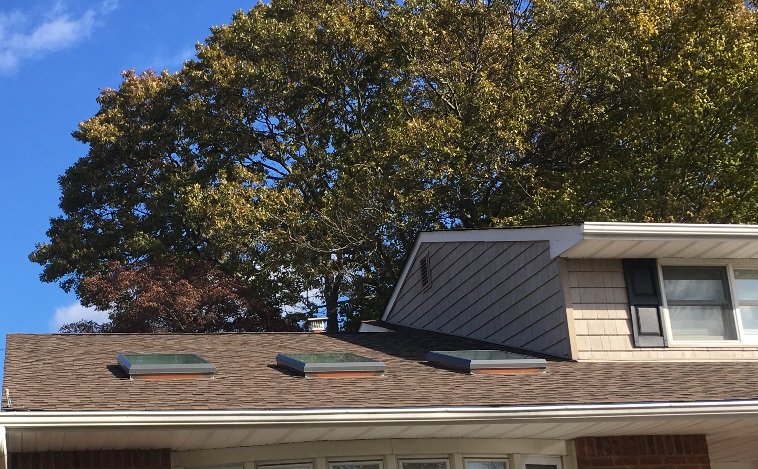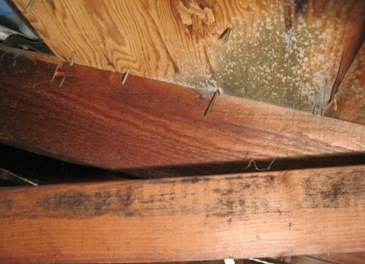Find a Mold Specialist Now
Click or Call, Toll-Free 24/7
Roof Leaks and Mold
A solid, well-constructed roof system protects and insulates your home, shielding your interior from nature’s elements. As your roof starts to age, worn or cracked tiles can lead to water infiltration and eventually leaks inside of your home. Sometimes leaks go unnoticed for a period of time and cause significant damage in your home, including problems with mold. Periodically inspecting your roof and attic will help you catch small problems before they lead to larger ones.
How Long Does a Roof Last?
A roof replacement is a major expense, and consequently, most homeowners want to prolong the life of their roof as much as possible. If you start to experience water infiltration, perhaps during a rain storm, you may be curious about whether it’s time to replace your roof shingles. Some roofs wear unevenly due to sun damage, exposure to natural elements like wind, or due to improper installation. In these cases, you may need to replace part or all of your roof system before the end of its typical lifespan. Since your roof is an exterior fixture, the climate can also have an effect on shingles, especially in locations where temperature extremes frequently occur. According to US News & World Report, the average asphalt shingle roofs last about 20 years. The national average cost of a roof replacement is $7,200, but this amount can vary significantly.
Roof Care and Maintenance
Due to the dangers of working in elevated areas, roof care and maintenance should only be completed by a professional roofing contractor. However, as a homeowner, you should keep thorough records of maintenance, warranty information and roof inspection reports. If you notice debris, or fallen shingles in your yard, save them to show your contractor. Have your roof inspected as recommended by the manufacturer, or if you notice water leaking inside your home. A professional roofer can help you determine where leaks are originating. Typically, a roof inspection includes the following steps:
- A visual inspection of the roof.
- A check on seals around areas where water could penetrate.
- The identification of shingles that may be worn, buckling, or otherwise damaged.
As a homeowner, you should also periodically have someone perform the following exterior maintenance tasks:
- Clean gutters – If gutters are filled with debris, water cannot run off the roof as intended. The pervasive dampness may lead to leaks and other roof damage.
- Trim back or remove trees close to the house that could potentially fall and damage the roof.
- Properly seal roof openings - Water can infiltrate any opening, no matter how small. Be sure that areas of the roof around skylights, chimneys and vents are properly sealed.
Also, remember to check your attic, or any area directly under your roof, where leaks may first penetrate.
 Asphalt Roof
Asphalt RoofSigns of a Roof Leak
Often, signs of a roof leak seem to appear without warning. You may notice that first trickle during a heavy rain, or find a small damp spot on your ceiling. Yellow or brown stains on drywall or ceiling also signal a potential roof leak. Following the leak to the point of entry is often difficult, but small leaks can eventually lead to larger problems, including drywall damage and mold.
Leaks may be caused by a wide range of factors, and it may be challenging to pinpoint the exact location of water entry. Sometimes, overall aging of your roof leads to a weakness in the system that causes water to penetrate. Uneven wear or improper installation of roof shingles may also be a contributing factor. Weather events, such as a heavy rain or a snow storm may also lead to a roof leak.
Some of the first signs of a roof leak include the following:
- Yellow or brown stains on ceilings
- Wet spots on ceiling or interior walls
- Leaking through windows or a fireplace
- Warped or buckled woodwork
- A musty odor indicating the possible presence of mold
What to Do if Your Roof Leaks
If your roof is leaking, you should first take immediate action to prevent damage to the interior of your home. If water is dripping, place a bucket under the leak. Move furniture away from the leak to preserve your fabrics and wood.
Next, work with a professional contractor to determine where the leak is coming from. Due to safety concerns and the great risk of injury, we recommend that all roof inspections and repairs be completed only by a professional roofing contractor. Professionals will have the proper training and the correct safety equipment to help them navigate your roof system. The contractor will recommend the best course of action to repair your roof and prevent future water infiltration.
If You Suspect Mold is Present
Dampness caused by some roof leaks can lead to mold growth within the home. Left untreated, mold can damage your home and cause health issues for those living in the home. In addition to drywall damage, the insulation behind the walls may be wet or moldy. Mold may also damage the wood underneath your roof shingles. Left untreated, indoor dampness and sitting water associated with roof leaks can lead to problems with mold and should be taken care of as soon as possible. If you’re unsure whether or not you have a mold problem, you can schedule a free home inspection from a mold removal company. If they find mold, they will let you know what’s involved in removing it, and give a price quote. To get a list of mold removal companies in your local area that offer free home inspections, you can complete this form.
Return From Roof Leaks To Our Black Mold Health Symptoms Home Page





